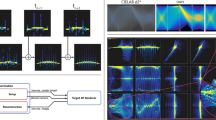Abstract
When displaying abstract objects, as in the case of scientific visualization, it is manadatory to give the user a maximum of cues to help him understand the displayed structures. In this short note, we describe two general, simple 2D postprocessing tools and their applications for the improvement of 3D perception by means of simulation of realistic 3D effects.
Similar content being viewed by others
References
Foley JD, Dam A van, Feiner SK, Hughes JF (1990) Computer graphics, principles and practice. Addison-Wesley, New York, pp 668, 727, 774
Haerberli P, Akeley K (1990) The accumulation buffer: hardware support for high-quality rendering. SIGGRAPH'90 Comput Graph 24:309–318
Rosenfeld A, Kak AC (1976) Digital picture processing. Academic Press, New York
Sims K (1991) Artificial evolution for computer graphics. SIGGRAPH'91 Comput Graph 25:319–328
Author information
Authors and Affiliations
Rights and permissions
About this article
Cite this article
Colonna, JF., Lactamme, G. Two 2D postprocessing tools and their applications to the improvement of 3D pictures. The Visual Computer 10, 239–242 (1994). https://doi.org/10.1007/BF01901580
Issue Date:
DOI: https://doi.org/10.1007/BF01901580




